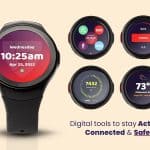
Spending time researching medical alert systems can make your decision a bit easier.
As you begin to research medical alert systems, you might find yourself feeling surprised by all the options that are available. Even just 20 years ago, there were just a few medical alert solutions on the market but today’s adults have a variety of companies, devices, and services to choose from.
Perhaps the most iconic medical alert system is Life Alert, as it is one of the first on the market. But how does Life Alert compare to other options available today? We’ll break it down for you here as we compare Life Alert with another popular and well-known service, Lifeline Systems.
Overview of Lifeline Systems (formally Philips Lifeline)
We’ll begin by introducing Philips Lifeline, which many consumers might know more simply as Lifeline. In 2006, Philips acquired Lifeline Systems and the company name became Philips Lifeline. This allowed the company to reach more families across the U.S. with its services. In July 2021, Connect America acquired Lifeline from Philips, and the company name reverted back to Lifeline Systems.
Lifeline claims to be the first provider of medical alert systems in North America and have served more than 7 million people since the early 1980s. Since the beginning, Lifeline Systems has worked to provide different options so that users can choose which type of device or service supports them best.
Currently, Lifeline Systems offers four major service options. The first is HomeSafe Standard, an in-home system that can be used via landline or cellular service. The HomeSafe Standard includes an in-home base station and a pendant or wristband.
The next option is HomeSafe with AutoAlert. This system includes the in-home communication device, pendant, as well as fall detection technology. This system is also able to be set up through a landline or cellular service.
The On the Go system includes both an in-home and on-the-go system that includes automatic fall detection. This option does not require a base station and is a single piece of wearable technology with the capability of two-way voice communication and GPS location.
Finally, Lifeline Cares was designed specifically for the family members of Lifeline Systems users. This app provides a new way to manage caregiving tasks and stay in the loop with any emergencies or communications from the Lifeline Systems devices.
Overview of Life Alert
Another option that has been around since the 1980’s is Life Alert. Well-known thanks to the “I’ve fallen and I can’t get up” commercials, Life Alert has been a leader in the medical alert industry since 1987. The company claims they help to save a senior’s life from a potential catastrophe every 11 minutes and field more than 2 million calls annually.
The Life Alert system has remained relatively unchanged since the early 80s, but it does offer a few options so that the user can customize it based on their needs and preferences. The in-home system connects to either a landline or cellular service and includes the base until as well as a wearable button users can press for emergency assistance.
Users can also choose the In-Home System with Help Button, which includes the waterproof HELP button that is most often used in the bathroom in case of emergency there. However, the button can be placed anywhere in the home and connects to the base system.
Finally, the Life Alert Mobile option includes on-the-go coverage and uses GPS to help locate the user when they press their button for assistance.
Lifeline (formally Phillips Lifeline) and Life Alert Similarities
Lifeline Systems and Life Alert are similar, and not just because they both have been around for as long as medical alert devices have been on the market. They both offer multiple solutions so that users can mix and match as their needs change, and both excel in offering in-home services with that base unit. Both have also expanded to meet the needs of a more active senior market, introducing an on-the-go option so their users aren’t tied to their base units if they need emergency assistance.
Emergency Response and Call Centers

Consider speaking with someone you trust, like your physician, when narrowing down your medical alert system choices.
It is essential to find a medical alert system and device that suits your needs and lifestyle, but it is also crucial to ensure that when you need help, your medical alert system can provide it quickly. Monitoring stations, staffed with dispatchers, are a key part of the emergency response system for both Lifeline Systems and Life Alert.
Lifeline Systems reports that a typical response, once an emergency button is pressed, is about 20 seconds. Their dispatchers are EMD certified but they are not a Five Diamond Certified Monitoring Center. Their landline system is automatically tested weekly to ensure communication is effective.
Life Alert has dispatchers that work in a Five Diamond Certified Monitoring Center and report a 15-20 second response time once a pendant button is pressed. They do not automatically test their system, but the equipment is designed to be self-diagnostic and will send a trouble signal if it detects any issue in communication or response.
Pricing Comparison
For many seniors, finding a medical alert device that fits into their budget is important. When researching your own medical alert options for yourself or a loved one, be sure you are checking for any extra fees that are on top of the monthly subscription fee. Here is a quick rundown of how pricing for Lifeline Systems and Life Alert compare to one another, at the time of this writing.
Lifeline Systems, no matter which option you choose, begin with a one-time activation fee and shipping charge. If you choose to install the system yourself, that initial fee may be as low as $19.95. However, if you have their professional installation providers install the system for you, the charge can go to $99.95.
Monthly rates for Lifeline Systems devices and services can range from $29.95 per month up to $58.95 per month. Activation fees range from $50-$99.95. It’s also important to note that customers of Lifeline Systems are not locked into a long-term contract. Instead, they can pay month-to-month and cancel at any time. Finally, Lifeline Systems is known to sometimes waive activation or shipping costs for new users, so be sure to ask during your conversation with them.
Life Alert charges a monthly fee of $49.95 for their basic system if it is connected to a landline. Without that landline, the monthly fee increases by $10. The Help Button plus the in-home system is $69.95 per month and the mobile option increases the cost to a total of $89.95 each month.
It’s important to note there is a set-up fee for Life Alert systems that can range from $95 to $198 depending on the system you choose. Life Alert also requires a 3-year contract. While you might be able to negotiate initial fees and monthly payments, that 3-year contract is the standard when working with Life Alert. Just be sure you are ready to commit to the device, system, and monthly fees long-term before you confirm your participation.
Our Pick
Our 3.5-star rating for Life Alert is based on pros such as their long history of serving seniors and their mobile medical alert system. We also like that they own their own TMA Five Diamond Certified Monitoring Center and that there are no equipment fees, shipping fees, or warranty fees. Cons that factored into our decision include their high costs and the 3-year contract with limited cancellation options. We also wish they had a system that utilized fall detection technology.
Lifeline Systems receives a 4-star ranking from us thanks, in part, to their self-installation option and automatic weekly system tests. We like that they do not require a long-term contract and that they do offer fall detection technology and other advanced system options. Cons for Lifeline Systems include a high monthly charge and a lack of activity monitoring or Five Diamond Certified Monitoring Center.
Compare More Medical Alert Systems
More and more adults are choosing to invest in medical alert systems as a part of their health and safety plans. It’s no wonder why: having a way to quickly contact someone in case of an emergency can add to peace of mind and confidence while moving around the home or while on the go.
However, it can be difficult to know which type of system and device is best for you or your loved one. Begin your research by comparing the options by price, options available that suit your lifestyle, and customer support. You can use our comparison tool that allows you to compare up to three companies at a time by specific features that include everything from discounts available to battery life to fall detection availability.
As you begin to compare options, you will find that narrowing down your list becomes much easier. Once you have a smaller pool of options, you can make a more confident decision. Good luck!


